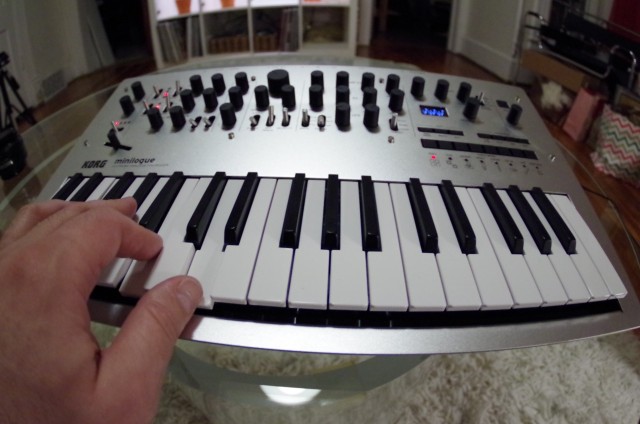
For years, Synthtopia readers have been asking for an inexpensive polyphonic analog synth. And for years, Synthtopia readers have had to settle for two out of three.
There have been inexpensive analogs, like the Arturia microBrute. There have been inexpensive polysynths, like the Roland JD-Xi or the Novation Mininova. And there have been polyphonic analogs, like Dave Smith Instruments’ flagship instruments.
But the inexpensive polyphonic analog has been elusive.
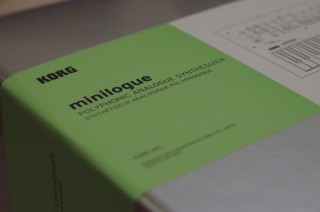 That changed this week, with the official introduction of the Korg Minilogue Polyphonic Analogue Synthesizer – a $500, fully-programmable four-voice polyphonic analog synthesizer, complete with a 16-step polyphonic note and motion sequencer, arpeggiator, and delay.
That changed this week, with the official introduction of the Korg Minilogue Polyphonic Analogue Synthesizer – a $500, fully-programmable four-voice polyphonic analog synthesizer, complete with a 16-step polyphonic note and motion sequencer, arpeggiator, and delay.
Can a $500 analog polysynth deliver the goods?
Read our Korg Minilogue synthesizer review to find out!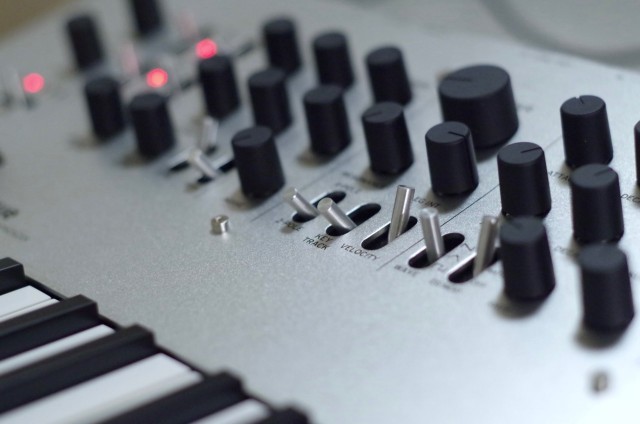
The Korg Minilogue is a four-voice polyphonic analog synth that features a traditional two oscillator + Noise, VCF, Dual ADSR, VCA architecture.
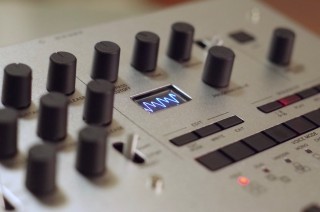 But while Korg’s recent analog synths have duplicated the architecture and styling of vintage synths, the Minilogue goes in a different direction, offering a variety of features that are either unusual or unavailable in the world of classic analog synths:
But while Korg’s recent analog synths have duplicated the architecture and styling of vintage synths, the Minilogue goes in a different direction, offering a variety of features that are either unusual or unavailable in the world of classic analog synths:
- The most obvious of these unique features is that the OLED display boots up to be an oscilloscope, showing you the shape of a cycle of the sound you are playing.
- Another unique feature is the Shape knob on the oscillators, which let you fine tune the shape and sound of the oscillators’ waves.
- The Minilogue also offers two filter types, per voice, with 4-pole and 2-pole cutoffs.
- A Delay section includes a single high-pass filter & a vintage-style delay.
- It offers a total of eight voice allocation modes that give you exceptional flexibility.
- It also includes a step sequencer that sequences voice parameters, in addition to notes.
The Minilogue does not compete with the power of high-end analog synths, of the past or the present. But it delivers traditional analog synth sound, combined with the flexibility and power of modern control, at an impressive price.

Design & Build Quality
The Korg Minilogue offers impressive build quality for its $500 price.
Other keyboards in the sub-$500 price range typically feature primarily plastic construction. And the Minilogue’s base is made of heavy plastic, too. But the areas that typically take the most abuse on a keyboard – the faceplate and back – are made of very rugged materials.
The faceplate is made of thick, sand-blasted aluminum. The back is a chunk of solid wood (Pyinkado). The controls feature chassis-mounted potentiometers and rubber-coated knobs.
As a result, the Minilogue looks and feels very sturdy, making its build a standout among minisynths.
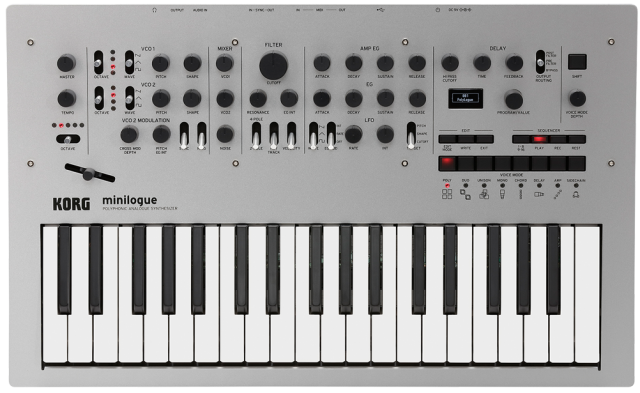
Just as important is the Minilogue’s interface design.
Minisynths tend feel cramped and some are plain confusing, because they pack so many features into a tiny design. Korg does several things to avoid this, with the Minilogue.
First off, the front panel is taller than most minisynths. This helps keep the Minilogue’s controls from being cramped together.
The Minilogue has its main controls laid out in a traditional left-to-right signal flow. Almost everything on the Minilogue has a dedicated knob or switch, which makes it highly tweakable. In typical use, most sound design and performance changes can be done using with a twist of a knob.
There are a few functions that require some menu-diving, but this is reserved for tasks that you are not likely to need to change frequently, like the pitch-bend range, how velocity maps to the VCA or LFO sync settings.
The panel is very legible, with high contrast black type over an aluminum background.
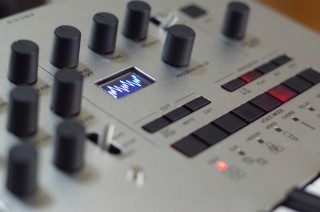 And Korg makes interesting use of the Minilogue’s OLED display.
And Korg makes interesting use of the Minilogue’s OLED display.
By now, you’ve heard that it serves as an oscilloscope, giving you a visual display of the way that your patch changes affect the synths’s sound. As you adjust the Square wave’s Shape, for example, you see the width of the pulse narrow or widen. And as you close the filter down, you see how it changes the wave’s harmonics.
Korg also makes effective contextual use of the display, displaying info that reflects whatever control you’re changing.
As a result of the intuitive layout and smart use of the display, the Korg Minilogue should be a fast learn for anyone that’s familiar with subtractive synthesis and a great first synth for people new to synthesis.
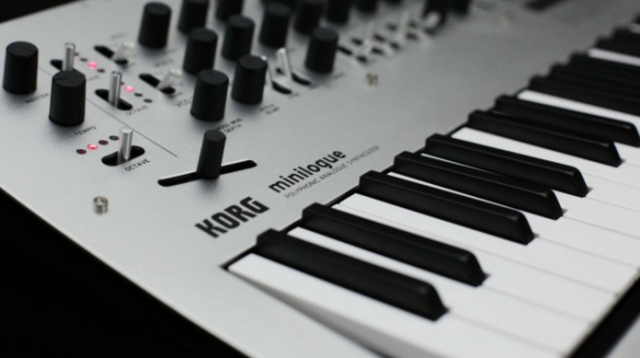
But what about the keys?
The keys are one of the few places where it feels like Korg had to compromise to get to the $500 price.
The Minilogue’s keys are about the same width as what you’d find on other minisynths, but longer. Here’s a comparison to the keys on a microKorg:
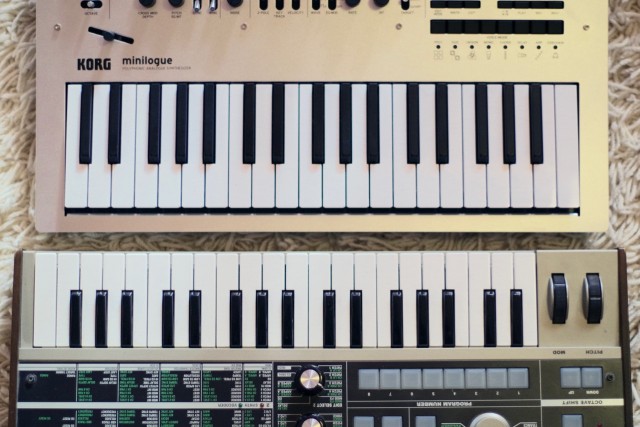
As you can see, the key width is about the same, but the keys on the Minilogue are about 50% longer, improving playability. Here’s how they measure up:
- Typical minikeys are about 3″ long.
- On the Minilogue, they are about 4 1/4″ long.
- And on a grand piano, keys are about 5 1/2″ long
We expect that the minikeys on the Minilogue will be a deal breaker for some players. If you’re a keyboardist that plays fast chromatic runs, the reduced key width means that your fingers can ‘stick’ between the black keys. For typical lead and bass line performance, though, the Minilogue keyboard is very usable.
One other quirk of the design is the diagonal mod slider. Some people will miss the standard pitch and mod wheel duo. We didn’t miss the modulation knob, since you can reach up and adjust any synth parameter you want, as you play. And the slider is assignable, which opens up some interesting performance options. The slider can control pitch bend on one patch, gate time on another and EG decay on the next.
Minor pet peeves of the Minilogue design are the headphone output on the back of the keyboard, rather than the front and the lack of MIDI Thru.
Synth Architecture
The basic architecture of the Minilogue is straightforward: two VCOs & Noise feed into a mixer; the output of the mixer feeds into VCF, which has a dedicated ADSR EG; this feeds into the VCA, which also has a dedicated ADSR EG. The output goes through an analog effects section, which features a high-pass filter and vintage-style delay.
With these elements, Korg gets the basics right. But Korg also includes some features that introduce significant sound design possibilities:
- The oscillators offer three waveshapes, but a Shape knob is also provided that lets you change the shape of the selected wave. This lets you get much more variety than static oscillators.
- The Minilogue also offers key modulation options, like oscillator cross modulation, pulse width modulation, envelope modulation of the oscillators, and LFO modulation of pitch, oscillator shape and filter cutoff, that expand the sonic capabilities beyond the basics.
Here is Korg Chief engineer Tatsuya Takahashi explanation of the Minilogue’s synth architecture. It’s worth watching in its entirety, because it offers a good introduction to the Minilogue’s architecture and musical demos of its capabilities:
Here’s a detailed look at the Minilogue voice architecture:
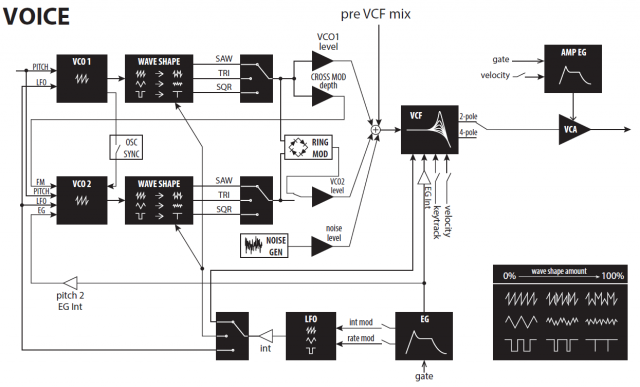
The Minilogue’s wave shape capability lets you fine tune the oscillators’ harmonics, giving you a much broader oscillator palette than the Sawtooth/Triangle/Square selectors would suggest. For example, with the Square wave, the Shape knob controls the pulse width – which can also be modulated by the LFO.
The Minilogue’s designers seem to have focused on providing as many options as they could provide dedicated controls for. So the Minilogue has dedicated controls for cross modulation, EG pitch mod and LFO routing to Pitch, Shape & Cutoff. But it doesn’t offer the power (and complexity) of deep matrix modulation that some synths offer.
 One of the most interesting aspect of the Minilogue’s architecture is the flexibility of its Voice Mode section, right.
One of the most interesting aspect of the Minilogue’s architecture is the flexibility of its Voice Mode section, right.
The Minilogue’s four voices can be allocated in eight different ways:
- Poly – this allocates the four voices as four individual notes
- Duo – this allocates the voices as two notes, letting you create richer sounds
- Unison -this mode is monophonic, with the additional voices creating a chorus effect
- Mono – this mode is monophonic, with the additional voices adding sub-octaves to the lead
- Chord – this allocates the voices to let you play ‘one-finger chords’
- Delay – this mode is monophonic, and the additional voices play after the lead voice, creating a delay or echo effect
- ARP – this is a standard arpeggiator, with many choices of arp styles
- Sidechain – this mode lets you hold a chord and, when you play over it, the new notes will reduce the volume of the held notes, bringing out the lead.
In each Mode, the Voice Mode Depth knob lets you customize how the mode works. For example, in Unison mode, the knob controls the amount of detune between the multiple voices. In Delay mode, it controls the delay amount. And in ARP mode, it lets you select the style of arpeggio.
The modulation Slider can also be assigned to Voice Mode Depth, which opens up some interesting performance options. This means that in Unison mode, for example, you can use the slider to control the detune of the voices; in Mono mode, you can use the slider to fade in the suboscillators; and in Delay mode, you can use it to add delay to one phrase of a solo.
Here’s a diagram that shows how the individual voices fit into the Minilogue’s synthesis architecture:
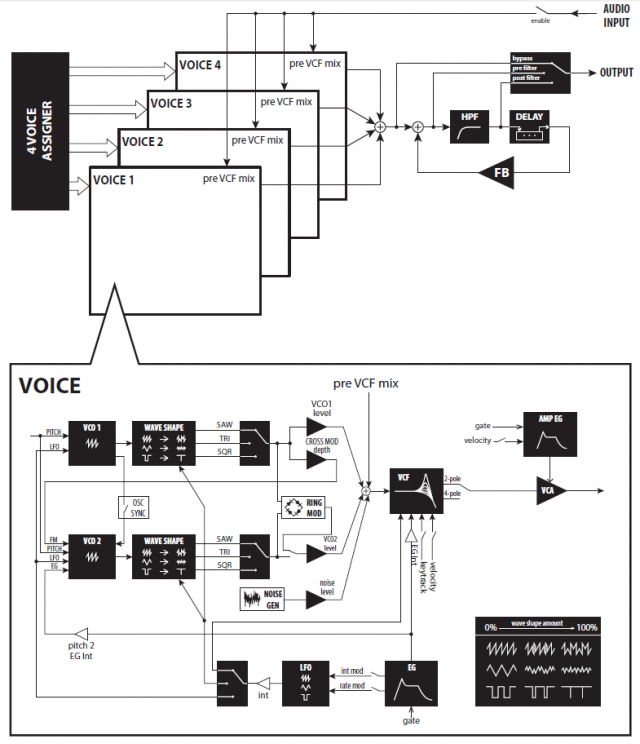
The Voice Assigner controls four voices, which then go through a single high-pass filter and an optional delay circuit prior to output. An audio input is also available.
Synthesis control options include:
- VCO1 – Octave, Wave (Saw, Triangle, Square), Pitch, Shape
- VCO2 – Octave, Wave (Saw, Triangle, Square), Pitch, Shape
- VCO2 MODULATION – Cross Mod Depth, Pitch EG Int, Sync, Ring
- MIXER – VCO1, VCO2, Noise
- FILTER – Cutoff, Resonance, EG Int, Filter Type (2-Pole, 4-Pole), Keytrack, Velocity
- AMP EG – Attack, Decay, Sustain, Release
- EG – Attack, Decay, Sustain, Release
- LFO – Wave (Saw, Triangle, Square), EG Mod (Int, Rate, Off), Rate, Int, Target (Pitch, Shape, Cutoff)
- DELAY – Hi Pass Cutoff, Time, Feedback, Output Routing (Post Filter, Pre Filter, Bypass)
Finally, the Minilogue offers a 16-step sequencer. You can vary the sequence length, and each sequence also supports four motion sequences, which record the settings for the Minilogue’s knobs or switches. This means you can make drastic changes to your patch, on each step of the sequence. Each of the Minilogue’s 200 patches can have a unique sequence saved with it.
The sequencer is missing one important feature – the ability to transpose a playing sequence from the keyboard. We hope that this can be addressed with a firmware update.
See the Minilogue’s Owner’s Manual, downloadable as a pdf, for details on MIDI support and more.
Minilogue Audio Demos
Features and build quality are meaningless if a synth doesn’t deliver the sound you want.
Here are a set of audio examples that demonstrate the power and range of the Minilogue:
The Minilogue excels in many of the classic analog synth roles, especially bass, leads and sequences. It also can do great polysynth sounds, but isn’t as strong a performer in this role, because of the limited polyphony and effects options.
Readers who are not familiar with classic analog synths should be aware that the output of the Korg Minilogue is more ‘raw’ than what you may be familiar with, because most modern synths include a standard set of effects, like chorus and reverb, and a stereo mix out. If you’re looking for more of a ‘finished’ sound, you’ll need to pair the Minilogue with external effects.
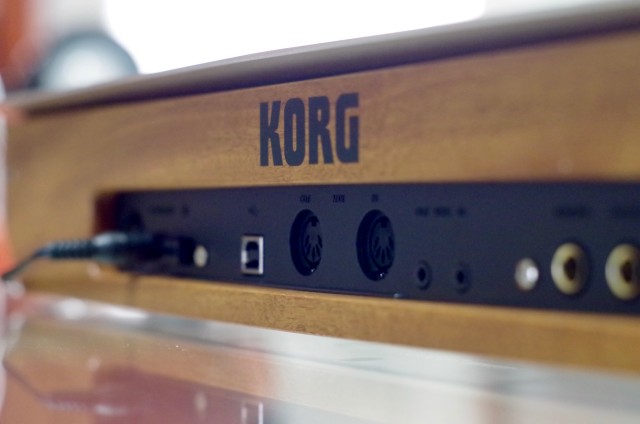
Summary
The Korg Minilogue impressed us out of the box, with its solid build quality, good looks and usable layout. And the Minilogue doesn’t just look good, it delivers the goods – raw polyphonic analog power.
The Minilogue excels at bass, leads and classic poly sounds. If you’re looking for lush, evolving pad sounds or to do more advanced sound design, a synth that includes a richer effects section, more flexible synthesis options and greater polyphony would be a better choice.
WIth the Minilogue, Korg has set a new standard for affordable polyphonic analog synthesis. We are impressed by how much Korg packs into the Minilogue and we think that many readers will be, too.
Pros
- Inexpensive. Polyphonic. Analog.
- Great build quality for the price
- Solid analog sound
- Great variety of performance modes
- Good performance ‘feel’ and tweakability
Cons
- Limited effects compared to other synths in the same price range
- Limited polyphony
- Fewer patching and modulation options than some similarly priced synths
Pricing and Availability
The Korg Minilogue will be available Jan 21, 2016, with a list price of US $499.99. See the Korg site for more info.

Has Korg won NAMM already?
Quite possibly.
Will Nick Batt of SonicState ever sign another NDA with Korg?
Probably not.
haha Nick was saying only on Wednesday he couldn’t talk about it while other guys were putting out full videos about it. he got mugged off.
Other sites were under embargo as well. They had review units and were told by Korg to sit on the story while it was leaked and spread around the web. KORG caused the problem themselves by providing details and photos to major publications weeks ago. There was no way the story wasn’t going to leak.
What Frodo said.
The main synth news sites have had Minilogues in house for a while and, from what I could see, none of them were sources for leaks.
The challenge for Korg and other companies is that they want to get the news in print magazines, which have long lead times, as soon as possible, and they want to have products listed at online retailers as soon as the products get officially announced. Most of the product leaks come from those two sources.
Do you really think it has leaked? Some people have already received theirs, which leaves one wondering whether several thousand units have physically leaked to store warehouses as well. My theory is, It was smart move on Korg’s side, who, expecting some competition on analog poly front this year, took action ahead of time and announced the synth early.
If they were to do so at namm, people would choose from several models, some not in favor of Korg, but now situation is: the competing products haven’t even been announced yet, and plenty of guys have already BOUGHT minilogue! Not that there’s anything wrong with that, but what has happened is very advantageous for Korg and makes one think they have not only got some of the best engineers but someone very smart in the marketing dept as well.
As a journalist, embargoes are common. They are not NDAs. You get a press release and it says you can’t discuss until “X”. I literally get dozens of these every day, so if people criticizing Sonic state are somehow insinuating that they are in league with Korg or something they just don’t know how the world works.
How do you think this thing stacks up against something like the Elektron Analog 4 Keys?
The Analog Keys costs more than three times as much, but offers a much deeper synthesis architecture, more effects, a better keyboard, more sequencing options, multitimbral voice allocation and individual voice outputs.
The Minilogue arguably bests the Analog Keys in immediacy and usability – there’s a hardware control for just about everything.
I’d actually say pairing this with an analog4 would be much more desirable than an analog keys
for one you get two synths, for two you still get keys, three you get midi controls for the a4, 4 you get a second sequencer and arpegiator, and it’s pretty much the same price.
I’d say if you plan on getting an analogkeys, consider minilogue and a4 at almost the same price
How have they arranged the editing for when the voices are stacked, in the mono/unison/duo modes? Are you stuck with them just being repeats of the front-panel settings, or can you edit them individually?
Also, regarding the front panel, there seems to be a fair bit of unused space there. Why not either spread things out a little more, or shink the size a bit? I’m aware that there’s the assorted bits of analogue circuitry in there, but I’d have thought there’d still be room to shave off another inch or so.
Otherwise, it looks pretty cool.
The Minilogue is not multi-timbral, so you can’t stack four different sounds to make a more complex monophonic sound.
They definitely could have shrunk the synth down more or reduced the depth of the front panel. It seems clear that their goal wasn’t to make this as small or smaller than other minisynths, though, but to make the Minilogue as great a synth as they could, at the $500 price point. The panel reflects that, taking up more space than other minikeyboards, but using the space effectively, so the synth feels visually balanced and uncluttered. Check out the photo above where it’s paired with the microKorg, as a point of comparison.
awesome synth but does any one feel this is lacking in the low end of the frequency spectrum?
my sub has ent a flutter
It can be as massive in the low end as you want, esp with the suboctaves on the monosynth Mode.
From the article, the cons: “Fewer patching and modulation options than some similarly priced synths.”
Which similarly priced synths did you have in mind? Thanks.
Look at the specs of digital synths priced under $500. Even the microKorg – an older design that’s showing its age – has multiple LFOs, multimode filters, a formant filter, vocoder, multiple types of effects, etc.
But those are digital synths, right? The Minilogue is analog – doesn’t that count for the features differences and price? I wouldn’t really compare a digital synth to an analog one when doing a price comparison…
Waldorf pulse 2 for example.
Would the sequencer be gateable via the korg sync in?
The manual includes an example of using the Sync In/Out to sync the Minilogue sequencer with the Korg Volcas.
Korg is the company to watch. There will always be critics here that say this feature is not there or this feature is not deep enough, but Korg seems to be listening to what we all most want and are willing to try to make it happen. All I can say is I really hope they jump into the euro ring.
The circuit will then be complete, when they left the group they were but to learn, now they are the masters!
just to be clear: theres one filter shared between the four voices – right? That seems a pretty important detail that none of the reviews have highlighted specifically. I know from experience with similiar synth architecture though that it definitely has a big effect on the way the instrument plays. I think I’m going to get this either way but can someone clear this up for me in the meantime?
No.. there is one filter (VCF) “PER VOICE”
Take a careful look at the Voice diagram above or listen to any of the pad videos available….
Example: https://www.youtube.com/watch?v=BhmcIipSy2U
No, there is one VCF per voice. See the diagram above.
That’s amazing! Thanks! Can’t wait to get my hands on it.
Each voice has its own LPF.
Then there’s a single HPF.
Available the 21st perhaps but mine came today and I love it!
Sally – We’ll be looking forward to seeing what you do with it!
Fu*k, I’m already tired of this thing.
“Korg Minilogue Synthesizer Review – The Affordable Polyphonic Analog Synth You’ve Been Waiting To Complain About”
They’re going to have to work on the Australian price which has been listed as between $900 to $1000 well above any exchange rate explanation. I’m quite happy to wait for a second hand one in a year or two than be repeatedly fleeced
especially Garak as its still under 1K and therefore doesnt attract import duty. so many will buy it from OS..including me if they dont come to the party. I say it should be around $700.. What is the local distr thinking morons. We dont deserve to get fleeced in this country like this so if they dont pull their socks up i will buy online. Enough is Enough.
Has the name ever been explained? My guess is that it was originally planned to be a monosynth called the Monologue, or possibly two voice para or polyphonic called the Dialogue. And when they added the full polyphony, it went from being a fairly standard-sized mono to a mini-poly, and they kept the “-logue” part because, eh, naming things is hard.
Enjoyed the review. I’m so psyched to get my hands on mine that I’m actually a little annoyed by the three day weekend for slowing it down.
Mini Analogue, seems pretty self-explanatory to me…
Whoops! So it is. Funny how the most obvious answer can be the one we’re completely blind to, like searching everywhere for your glasses when you’re wearing them.
Still think Monologue would be a cool name for a monosynth though…
several months later and turns out you are right lol.
I keep wanting to call it the Kylie Minilogue lol
And the KMFDM Fuck Kylie Minilogue recolor and new patch set.
It’s because it has a mini log of wood on the back.
One member of the group Minilogue wrote on his Facebook page:
“The team behind this new synthesizer are fans of Minilogue and Son Kite… they have attended on many of our live shows in Japan during the years.
I am honored and very happy that they wanted to name theire (sp) new creation after us!”
The name is apparently a contraction of “minimal dialogue.”
How fast does the lfo go? How does it compare with a monotribe?
Does this thing output midi via the arp/seq? Do the knobs output midi?
Thx!
All controls do, but I don’t know about the sequencer, and that would be a great feature indeed.
—
And please, somebody make a demo for warm, vintage, bassy sounds. I really like the design and features, but everything I’ve heard so far sounds far too bright and hollow…
The sequencer outputs MIDI. The arpeggiator does not. This is something that could (presumably) be added via a firmware update.
Good to know. Thank you!.
“The sequencer outputs MIDI. The arpeggiator does not. ”
That’s typical of keyboards – the arp is interpreting the midi notes that you actually play and adding the arpeggiation. Otherwise things would get weird when record MIDI and play it back through your arpeggiated patch.
How is the resolution of the Knobs (128 or 256 steps)? Can you hear filter stepping? I guess it’s digital controlled analog synth to save preset. And can you drive the filter with higher mix levels of the oscs?
Those are 10 bit controls, 2^10=1024 steps.
127 steps when controlled externally via midi though.
No stepping with the filter when using the knob, but you would probably hear it if using midi to control it. There is no way to drive the filter, which is something that I’m not used to.
Hmm… seriously thinking about one of these to replace my Arturia Microbrute SE, Minibrute and Novation Bass Station 2. The only thing it lacks in my view is a decent keyboard – three octaves is not enough. It has ‘sync in/out’ – which is similar to the Volcas. So I am presuming it will integrate nicely with those and my SQ-1. I might keep the Microbrute, and let the Minilogue replace the other two. But the price looks good, and it looks a powerful bit of kit.
why replace your monosynths with a poly? why not use this to *complement* them?
I think this would compliment the Bass Station 2 very well. Both have a sort of rawness to them.
I would keep the synths you have, even if you are buying a minilogue. It’s nice to have different timbres available. Different tracks could use the touch of different synths. Using several different synths to get nice layers for a part is useful too. Plus you can use the brutes together as a duophonic synth, or a 2 osc mono synth, and the filter is pretty great as well. I’d wait until after you bought your next piece of gear to decide wether or no anything has worn out its welcome.
I see there is a FM feature that is controlled by the cross mod depth feature. Though I haven’t heard anything typically FM, this looks like an interesting feature.
http://medias.audiofanzine.com/files/korg-minilogue-owner-manual-474968.pdf
Really?…Maybe keeping a Minibrute and Microbrute has no point. But Brutes-BS2-Minilogue seem to me very different synths with very distinctive character each (and I can’t say I like Minilogue’s character so far…).
If there is a piece of hardware I will always keep that will be the BS2: non-fabulous raw sound but warm and full overall tone, even if it can sound aggressive and nasty if you want to. Pluses: nice full-sized keybed with velocity and aftertouch, and a convenient if very simple sequencer with transposition from the keyboard, latch button (Minilogue missing those two features at the moment) and MIDI out. The more time I spend with it the more I like it. I don’t think is casual the appreciation for this synth has grown exponentially since its release.
In fact I would love Novation to make its own affordable poly analog. It won’t look as nice as this one though…
For me, size of the keys isn’t the big problem. What is the problem for me is that the mini keys snap off when played excessively. My microkorg has 4 black keys repared and korg doesn’t sell plastic octaves, only the whole keybed with electronics. Who has or knows about karp odyssey or ms20 mini and how long the keys on them last?
“What is the problem for me is that the mini keys snap off when played excessively. ”
You might be doing it wrong….
I can sympathize. I have a heavy touch. Even when typing on a laptop, I shake the room.
Well, first of all, these keys are the same as found on the Korg ARP Odyssey and MS-20mini which are larger and more playable than actual “minikeys” like on the MicroKorg. I play my Odyssey for 3 hours a night in my band as a dedicated bass synth, and so far the only issue I’ve had is a little “clacking” noise from one key. This synth has spent many many many hours under my fingers. I think you don’t have anything to worry about!
So you are not gonna mention the clicking sounds the envelops make with a low attack?
Is it any more clicking than usual? How can a short attack NOT click?
All analog envelopes make a click sound with super short attack times.
That has been a characteristic of analog envelopes forever. Very few are designed to get around this, and then it is usually by shifting the envelopes into digital.
Even digitals click with a short enough attack. A rapidly changing envelope is equivalent to amplitude modulation. It’s a form of distortion. If the ramp is fast enough it will briefly generate frequencies not in the original signal. It’s pretty hard to get around this, especially with free-running oscillators.
It is more than usual, and it clicks with oscillators turned all the way down and/or filter turned all the way down.
The click seems to have a bit of a tail to it, so even when you dial it out with a slightly longer attack you still hear a small thud.
Am I correct in understanding that the Minilogue does not have sub-oscillators? I don’t see them on the panel, but they may be accessible via a menu dive.
Another 4 voice analog poly that comes to mind is the Dave Smith Instruments Mopho x4. The DSI synth has more extensive synthesis capabilities, and it has the sub-oscillators. It also has great build quality and full size keys (with a 3 1/2 versus 3 octave keyboard). However, the Mopho x4 is over twice the price.
For $500, the Minilogue packs a lot into a synth. I suppose while it’s good to compare features with other synths to determine where to best spend your hard earned synth budget money, the Minilogue will not sound just like the Mopho x4 and vice-versa. So, it’s a bit like apples and oranges.
Why didn’t I win the Powerball? That would have solved any synth budget shortcomings. I could have bought both synths (and many more). I should be getting some money soon from the Nigerian Lottery. I already sent in my money to redeem the prize. When I get the lottery money, I will get on the Sweetwater website and order a Minilogue, a white-faced Odyssey, a Mopho x4, and a Prophet 12.
When the voice mode on the Minilogue is set to mono, the voice mode depth dial allows you to dial in one or two square sub oscillators 1 and 2 octaves below
I too have monies waiting to be sent from the Bank of Nigeria, I just had to send a fee for $885 dollars to get the monies
I would wait till NAMM. Dave Smith and other companies are definitely not sleeping and during NAMM could come some serious budget suprise from them. Maybe guys from Korg know that and therefore they started with this campaign before the show. After NAMM, i will decide if minilogue is still such a gamechanger and a good deal.
Does the Minilogue send and receive midi CC information? I am always looking for a controller for iOS and DAW soft synths.
Will the Minilogue echo the din midi in the the USB midi out?
Is USB class compliant?
Yes it does! Send and receive but 128 steps only.
It is also Class Complaint
So reviews everywhere are praising Korg for indroducing a fully polyphonic analogue synth at a newly affordable price not seen before, but this site lists in the Cons – limited effects compared to other synths in this price range (what polyphonic analogue synths would they be?), limited polophony (errr yes are we hoping for 8 voices at this pricepoint?), and limited modulation compared to some synths at this price point (again what analogue polysynths at this price point are we speaking of?)
Surely it’s a huge pro at this pricepoint that it’s polyphonic – therefore you can’t then say a downside is that there isn’t even more polophony.
not overly helpful for noobs who look at those cons and think -“hmm this synth seems to be lacking in some areas compared to many synths at this pricepoint” Where the opposite is true
Slightly unfair and misleading pro’s/con’s
Conen
You’re limiting your comparison to analog polysynths, which our ‘cons’ list does not specify.
It’s relevant to readers that there are similarly priced synths that offer deep effects options, are multi-timbral, offer 20 times the polyphony, etc.
That does not take away from Korg’s accomplishment. Analog synths come at a premium and readers understand that.
If you’re going down that road, why not also point out that it doesn’t have a digitally sampled grand piano patch?
Instead of listing these items as “cons” it might be better to just add a paragraph for synth noobs to explain the difference between an analog synth and a digital one. Anyone shopping for a general purpose “synthesizer” will be disappointed with a unit like this, and the comparisons only add to the confusion.
If I was considering buying a Camry and wandered into the Ducati dealership by accident, I would not want the salesperson to start telling me pros/cons of buying a motorcycle instead of a sedan.
The cons make sense to me. It’s not being compared to other _analog_ synths. Just to other synths in its price range. People who demand more polyphony and more modulation features and flexibility might well choose a digital synth instead.
This is clearly a great price for an analog polysynth, and I think the excitement it’s generated proves that point.
yeah I understand that to a degree – but lets take a moment to consider an example. They are reviewing a Microbrute, Bass Station ii, moog minitaur, MS20 mini or something along those lines, would we expect it to say in the Cons – “monophonic only so vastly inferior polyphony compared to many synths in this pricerange”
It’d make more sense to say “limited in this manner compared to digital ALTERNATIVES in the same pricerange.
That’s a good point. I do think it’s fine to emphasize that if you want a poly, this might not cover all your use cases. 4 voices is tricky for some playing styles. If you have pads with long decays and releases, you’re going to find the voices stolen away from you rapidly as you change chords. I have the same complaint with the Boutiques. Prophet 5 had (obviously) 5, and I thought that extra voice really helped. Obviously if this had 6 or 8, it would cost more, so I have no problem with Korg sacrificing to hit $500. But it’s fair to point out the limitations caused by the compromises. Every synth is a compromise, after all.
price aside it lacks features to be a good synth, it won’t take long to exhaust its potential. another lfo with greater routing would have been the min requirement
but at the price its eye catching
It does have 4 lanes of motion sequencing though – which act like extra modulation sources – you can just record knob tweaks on the sequencer without recording notes, then play over the top of it while it’s running – overdubbing movements on the fly. Lot of potential there
Sounds like you’ve never used a Roland Juno – very basic synths that sound awesome and get used all the time. The Alpha Juno is inferior to the Minilogue in just about every way, yet everybody considers it a classic.
In fairness, the Alpha Junos are a pain to edit and you need to make sure you have spare voice chips to keep a 106 running in the 21st century.
That’s why Roland made a separate control surface with dedicated sliders for everything…that sells for much more than an Alpha 1 or 2.
It is a dream with that controller.
After a quick look in the manual I found a setting within the menus (button 4) where you can set the amount from 0 to 127 that velocity affects the amplitude of the notes. That’s ideal. It’s even better than the filter which only gives you three settings: 0, 50% and 100%. But that’s all just fine and good. That designer really deserves a vacation, and a raise, and a holiday bonus.
stub on:
Isn’t 0% 50% 100% for the filter keyboard tracking amount ?
https://www.youtube.com/watch?v=chlTY486T7w strange loud plopping going on here?
There’s do discussion in that video of what the problem is. I watched it a couple times but kept feeling as if I had walked into the middle of a conversation. What’s the point?
Tons of analogs do this same thing. It’s a burst from the VCA opening fast.
Add a smidge of Release time and it goes away.
Learn to program a synth.
With the envelope attack at zero, it makes a very short ‘click’. People that have used a lot of analogs will be familiar with this. It’s a flaw to some and a feature to others.
The Minilogue is also noisier than a digital synth.
We could come up with a lot of other things to nitpick, but they are pretty minor in the context of getting a robust $500 analog polysynth.
We noted the cons that will affect the most players. The minikeys, lack of effects and 4-voice polyphony, are especially worth noting, because they are compromises that directly impact performance.
Is it me, but this is like a prophet 5 (or maybe a prophet 4?) with some add ons? sonically and in design? great synth!
I can wait for Korg to drop the real bomb nobody sees coming next week. Just know the Minilogue was just the jab setting up the right hand. Thats why I’m waiting to buy the 8 voice Biggielogue (male jigalo)
It sounds like an optimized Volca keys.
Just wondering if the author completely forgot the Dave Smith Instruments Tetra? Sure it doesn’t compare to the Minilogue today but it was both accessible in price and four voice polyphonic (with true multitimbrality) when it was released.
WTF? Were you expecting them to namecheck the entire history of synths or something?
Even if I was totally sold, I’d still wait till namm
People mention the Novation BS-2 and Arturia Brute’s.
Daniel just mentioned the Dave Smith Tetra.
I think this is like a 4-voice version of the Dave Smith Mopho … minus sub-oscillators etc.
Anyone agree ?
The Tetr4 is a 4-voice Mopho, the Minilogue is a completely different synth with a different filter and different sound!
The Mopho has far, far more modulation options. That’s not a knock though, sometimes simple is good.
Rexternal control I/O control:-
1. With only one mod lever/stick, Korg should include an external input for an expression pedal.
2. With no Arp / Sequencer latch (on/off start/stop) button – Korg should include an external input for a foot switch pedal… could this be hacked ???
3. With no Arp / Sequencer latch button – can these be triggered by MIDI transport commands ?
4. What is the step-resolution of the knobs… are they rotary encoders or 0~270.degree pots?
on conventional analog synths, you get 0~270 degree pots with smooth turn (no stepping). However the Minilogue shows the parameter value steps in the display.
5. Can the USB-MIDI and DIN-MIDI convert each other in both directions as ?
You can assign the mod lever to whatever you want. Other values can be changed by turning a knob.
The arp is part of the sequencer. Pressing Play does latch it on until you press Stop. The way the arp runs through notes is dependent upon what mode you set for it. It has 13 different ones.
Resolution on knobs is 1024. On MIDI it is standard 127.
With Motion sequence you can choose to retain step resolution between knob movements to keep a stepping effect on changes, or smooth the transition between values to eliminate stepping.
No idea on MIDI/USB. The unit can send an receive via both.
Too elaborate.
You set the Key/play mode to arp. Select the type of arp pattern with the knob.
Then program your arp in the sequencer and hit play.
I think 2 of these would steal the show
Hopefully, this (Minilogue) will lead to the next logical step: manufacturing new analog polysynths with 8 voices, split/layer ability and full size, 5 octave keyboards with polyphonic aftertouch. We all see it coming, don’t we?
Why 8?
There are already 4, 6, 12 – analog polys available.
Not necessarily. Korg, Roland, & Yamaha are going for small price points so that they can move a lot of units.
Very few young artists will want to drop $3,000 on an analog polysynth.
Affordable?! At $900 here in Australia…not!
Does it outdo the cheaper Roland JD-Xi in any way? I mean practical, not in good looks and veneer backside (!?) but in sound quality and possibilities… The demo’s don’t look too promising…
Your comment suggests that you either don’t know much about synthesis, or that you don’t understand the completely different synthesis architectures of the Minilogue and the JD-Xi.
The voice architecture of the two synths is completely different, so there are some things that the Minilogue can do that are impossible on the JD-Xi, and vice-versa.
I wanted to like the JD-Xi, but played one in a store and was not impressed. You can hear stair-stepping when you tweak a knob on the synth, so there is not enough control resolution to do the job they set out for.
I also have the Mopho and to me the difference is that everything is a menu deep-dive with DS. It sounds great, but I have not bonded with it from a sound-tweaking or live performance point-of-view.
The appeal of the Minilogue is the immediacy of having physical knobs on the front panel and the 4-voice analog poly. There is nothing else like this currently on the market today. It will have a place of honor beside my MS-20 Mini and my Karp Odyssey.
Saw the jdxi in the store and was pleasantly surprised. I think it’s very different than the ML. Jdxi is more of a groovebox mentality, with a sequencer that can make more of a complete track. ML is strictly analog polysynth. I bet they would pair well together!
It’s me, or the demos… but I cant find the warm tones of an analog. I mean, it seems that the original Microkorg is delivering more analog sounds than this one. I was truly exited at first, but after hearing the available demos I’m not so sure if this is better than the Microkorg (except by the larger keys and one knob per function).
“Readers who are not familiar with classic analog synths should be aware that the output of the Korg Minilogue is more ‘raw’ than what you may be familiar with, because most modern synths include a standard set of effects, like chorus and reverb, and a stereo mix out. If you’re looking for more of a ‘finished’ sound, you’ll need to pair the Minilogue with external effects.”
Traditional analog sounds can be pretty ‘naked’ without effects. All those great Vangelis CS-80 synth sounds that people love are really the synth plus some massive effects.
I wasn’t looking for a more “finished” sound. I guess that I’m comparing it with the MiniBrute, (my first analog) which can deliver a fuller rounded and sweet sound if you have the oscillator mixer below the middle. The Microkorg is closer to that too. I’m not comparing it with a Moog or other very expensive classic synths which I’d never played for they are totally out of my budget and I only know via Arthuria’s VSTs.
To my ears the sound in the demos is close to a Volca (I cant say why), but alas, almost every review is just a preset tour and cliche synth licks. I also know that a YT review is nowhere close to the real thing live. Anyway I would love to hear some real stuff with the Minilogue and also actual sound creation.
I own an MS2000 (same engine as Microkorg) a Minibrute, and a Minilogue. I’d say that the Minilogue does have a slightly less aggressive character than the Minibrute, but not by much, especially in Mono voice mode. I find the Minilogue does its own thing, and very well. I could not be more pleased–an analog poly at this price is unprecedented. The Microkorg/MS2000 doesn’t have anywhere near the sound of the Minlogues oscillators–the Microkorg is clearly is clearly digital, and nowhere near as punchy, or pleasantly imperfect; but that’s not a bad thing, either–I find my MS2000 great for other things. Virtual analogs have other issues, such as filter stepping, aliasing, etc. I’d say have a listen on decent phones in a music store, then decide. YouTube audio compression doesn’t help much, either. The review here is right on target.
And here it is. This has sold me the synth.
https://www.youtube.com/watch?v=lKy-4GRrf_0
The end of this review states that this synth will not excel at polyphonic patches like pads, etc. due to the “limited polyphony and FX”.
Well, the Prophet-5 only had 5 voices and zero FX, and sounded amazing and ended up on hundreds of records!
Why these complaints about mini keys on a device with midi in?
The keybeds in this and other mini key synths are quite cheap.
Had the maker used full sized keys, they would still use cheap keybeds. So a lot of keyboard players would then still complain about the keys.
There are full sized keys that are even worse to play, than the keys on this particular synth.
I had the oppurtunity to test it today. So it’s not just speculations.
Then you might say, why did they not go for a strict module?
Many stores wont rig modules synths so they are playable from a keyboard.
And still, even when rigged, people are more likely to give a keyboard synths a try, than modules that are hooked up.
So then why not both?
To save some money, at least on the initial run.
To people that are not primarily keyboard players, mini keys are not as big of a problem.
Even a lot of keyboard players can learn to play these keys. And if used as a secondary device, the keybed is fine.
So for a lot of potential buyers, wont be bothered that it has mini-keys instead of full keys.
By using mini keys, it’s a lot smaller for people that wants to use it as a module, be it on stage or in a studio.
For all that likes the synth, but don’t like the keys, get a good midi keyboard (or hook it to another synth).
Or wait for a module version, but if that ever happens, it might take a while. If you like the synth, a module version would not be much cheaper, as the keybed is quite cheap. So my suggestion is to get it anyway.
A second hand great keybed wont cost you more than would be added to the price of this synth, if korg makes a version with a great keybed.